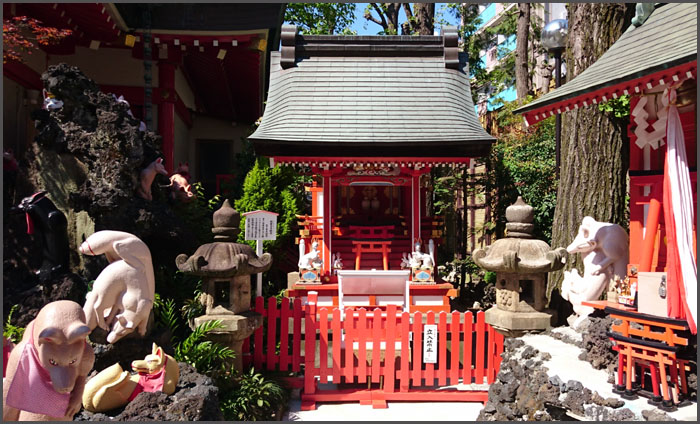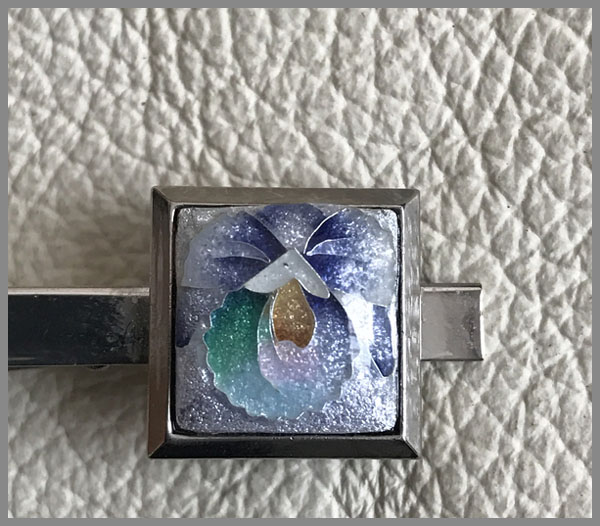[ . BACK to DARUMA MUSEUM TOP . ]
. Famous Places and Power spots of Edo 江戸の名所 .
::::::::::::::::::::::::::::::::::::::::::::::::::::::::::::::::::::::::::::::::::::::::::::::::::::::::::::::::::::::::::::::::::::::::::::::::::::::::::::::::::::::::::::::::::::
Susaki, Suzaki 洲崎 / 須崎 / 州崎 Susaki district
Koto ward, 東京都江東区東陽一丁目の旧町名 The old name for 東陽一 Higashiyoichi first sub-district

Due to landfill in the early Edo period, this area became known as
深川洲崎十万坪 Fukagawa Susaki Jumantsubo.
It was known for its beautiful scenery.
In 1888, a pleasure quarter from Nezu was moved here.
Until 1958 there was a large pleasure quarter, the 洲崎パラダイス Susaki paradise".
There is also an area called Susaki in 墨田区向島5丁目 the fifth sub-district of Mukojima in Sumida ward, with the spelling 須崎.
Another Susaki 洲崎 is known in 千葉県 Chiba and 神奈川県 Kanagawa.
In the Edo period the river 小名木川 Konagigawa was used for transportation from the Susaki area to the fish markets of Edo.
In 1791, there was a great flooding of the area and many merchants lost their estates. Since then the Bakufu government forbid to build living quarters in Susaki.
The area was always popular for shiohigari 潮干狩り hunting for clams and seafood on the shore

Jūmantsubo 深川州崎十万坪 Jumantsubo Plain at Fukagawa Susaki
Utagawa Hiroshige
::::::::::::::::::::::::::::::::::::::::::::::::::::::::::::::::::::::::::::::::::::::::::::::::::::::::::::::::::::::::::::::::::::::::::::::::::::::::::::::::::::::::::::::::::::
Susaki Benten 洲崎弁天
浮弁天州崎神社 Uki Benten, Shrine Susaki Jinja
江東区木場6-13-13 Koto ward, Kiba

- Fukagawa Susaki Benten
Utagawa Kuniyoshi 歌川国芳

Shrine Susaki Jinja 州崎神社
The Shrine was under the special protection of the mother of 将軍徳川綱吉 Shogun Tokugawa Tsunayoshi.
People came here to pray for protection from water disasters and for good fishing.
The Shrine was on a small island on the beach, thus called
uki-Benten 浮き弁天 the floating Benten shrine
In modern times all this became landfilled and nothing of the atmosphere of Edo is left.
- One of the
. Edo roku Benten 江戸六弁天 Six famous Benten in Edo .
::::::::::::::::::::::::::::::::::::::::::::::::::::::::::::::::::::::::::::::::::::::::::::::::::::::::::::::::::::::::::::::::::::::::::::::::::::::::::::::::::::::::::::::::::::
. Legends and Tales from Japan 伝説 - Introduction .
................................................................................. Susaki 洲崎
hamaguri 蛤 clam shell
At the beach of 洲崎浜 Suzakihama in Shinagawa, in the eleventh lunar month,
some fishermen were peeling clam shells, when they found one with a very small golden statue of 地蔵 Jizo Bosatsu inside,
. hamaguri 蛤 clam shell, Venus clam .
..............................................................................................................................................
- reference : nichibun yokai database -
. Edo, Tokyo 江戸 - 東京 - 伝説 Legends Index .
::::::::::::::::::::::::::::::::::::::::::::::::::::::::::::::::::::::::::::::::::::::::::::::::::::::::::::::::::::::::::::::::::::::::::::::::::::::::::::::::::::::::::::::::::::
- - - - - H A I K U and S E N R Y U - - - - -

洲さき汐干かり shiohigari at Fukagawa Susaki 深川洲崎 in Spring
Hiroshige
. Kobayashi Issa 小林一茶 in Edo .
深川や桃の中より汐干狩
Fukagawa ya momo no naka yori shiohigari
Fukagawa !
through the peach blossoms
people are gathering shells
Tr. Gabi Greve
. WKD : shiohigari 汐干狩 hunting (for clams and seafood) on the shore .
shiohigari - gathering shells and small seafood at low tide.
Fukagawa had a great flatland tidal area where people could collect cheap seafood.

::::::::::::::::::::::::::::::::::::::::::::::::::::::::::::::::::::::::::::::::::::::::::::::::::::::::::::::::::::::::::::::::::::::::::::::::::::::::::::::::::::::::::::::::::::

- - - To join me on facebook, click the image !
:::::::::::::::::::::::::::::::::::::::::::::::::::::::::::::::::::::::::::::::::::::::::::::::::::::::::::::::::::::::::::::::::::::::::::::::::::::::::::::::::::::::::::::::::::::
. . Kootoo, Kōtō 江東区 Koto ward, "East River" . .
. Famous Places and Powerspots of Edo 江戸の名所 .
. Edo bakufu 江戸幕府 The Edo Government .
. Doing Business in Edo - 商売 - Introduction .
. shokunin 職人 craftsman, craftsmen, artisan, Handwerker .
. senryu, senryū 川柳 Senryu poems in Edo .
. Japanese Architecture - The Japanese Home .
. Interior Design - The Japanese Home .
. Legends and Tales from Japan 伝説 - Introduction .
[ . BACK to DARUMA MUSEUM TOP . ]
[ . BACK to WORLDKIGO . TOP . ]
- - - - - #susaki #suzaki #susakibenten - - - -
::::::::::::::::::::::::::::::::::::::::::::::::::::::::::::::::::::::::::::::::::::::::::::::::::::::::::::::::::::::::::::::::::::::::::::::::::::::::::::::::::::::::::::::::::::
--
Posted By Gabi Greve to Edo - the EDOPEDIA - on 2/08/2019 01:22:00 pm
Unsubscribe from new post emails for this blog.
. Famous Places and Power spots of Edo 江戸の名所 .
::::::::::::::::::::::::::::::::::::::::::::::::::::::::::::::::::::::::::::::::::::::::::::::::::::::::::::::::::::::::::::::::::::::::::::::::::::::::::::::::::::::::::::::::::::
Susaki, Suzaki 洲崎 / 須崎 / 州崎 Susaki district
Koto ward, 東京都江東区東陽一丁目の旧町名 The old name for 東陽一 Higashiyoichi first sub-district

Due to landfill in the early Edo period, this area became known as
深川洲崎十万坪 Fukagawa Susaki Jumantsubo.
It was known for its beautiful scenery.
In 1888, a pleasure quarter from Nezu was moved here.
Until 1958 there was a large pleasure quarter, the 洲崎パラダイス Susaki paradise".
There is also an area called Susaki in 墨田区向島5丁目 the fifth sub-district of Mukojima in Sumida ward, with the spelling 須崎.
Another Susaki 洲崎 is known in 千葉県 Chiba and 神奈川県 Kanagawa.
In the Edo period the river 小名木川 Konagigawa was used for transportation from the Susaki area to the fish markets of Edo.
In 1791, there was a great flooding of the area and many merchants lost their estates. Since then the Bakufu government forbid to build living quarters in Susaki.
The area was always popular for shiohigari 潮干狩り hunting for clams and seafood on the shore

Jūmantsubo 深川州崎十万坪 Jumantsubo Plain at Fukagawa Susaki
Utagawa Hiroshige
::::::::::::::::::::::::::::::::::::::::::::::::::::::::::::::::::::::::::::::::::::::::::::::::::::::::::::::::::::::::::::::::::::::::::::::::::::::::::::::::::::::::::::::::::::
Susaki Benten 洲崎弁天
浮弁天州崎神社 Uki Benten, Shrine Susaki Jinja
江東区木場6-13-13 Koto ward, Kiba

- Fukagawa Susaki Benten
Utagawa Kuniyoshi 歌川国芳

Shrine Susaki Jinja 州崎神社
The Shrine was under the special protection of the mother of 将軍徳川綱吉 Shogun Tokugawa Tsunayoshi.
People came here to pray for protection from water disasters and for good fishing.
The Shrine was on a small island on the beach, thus called
uki-Benten 浮き弁天 the floating Benten shrine
In modern times all this became landfilled and nothing of the atmosphere of Edo is left.
- One of the
. Edo roku Benten 江戸六弁天 Six famous Benten in Edo .
::::::::::::::::::::::::::::::::::::::::::::::::::::::::::::::::::::::::::::::::::::::::::::::::::::::::::::::::::::::::::::::::::::::::::::::::::::::::::::::::::::::::::::::::::::
. Legends and Tales from Japan 伝説 - Introduction .
................................................................................. Susaki 洲崎
hamaguri 蛤 clam shell
At the beach of 洲崎浜 Suzakihama in Shinagawa, in the eleventh lunar month,
some fishermen were peeling clam shells, when they found one with a very small golden statue of 地蔵 Jizo Bosatsu inside,
. hamaguri 蛤 clam shell, Venus clam .
..............................................................................................................................................
- reference : nichibun yokai database -
. Edo, Tokyo 江戸 - 東京 - 伝説 Legends Index .
::::::::::::::::::::::::::::::::::::::::::::::::::::::::::::::::::::::::::::::::::::::::::::::::::::::::::::::::::::::::::::::::::::::::::::::::::::::::::::::::::::::::::::::::::::
- - - - - H A I K U and S E N R Y U - - - - -

洲さき汐干かり shiohigari at Fukagawa Susaki 深川洲崎 in Spring
Hiroshige
. Kobayashi Issa 小林一茶 in Edo .
深川や桃の中より汐干狩
Fukagawa ya momo no naka yori shiohigari
Fukagawa !
through the peach blossoms
people are gathering shells
Tr. Gabi Greve
. WKD : shiohigari 汐干狩 hunting (for clams and seafood) on the shore .
shiohigari - gathering shells and small seafood at low tide.
Fukagawa had a great flatland tidal area where people could collect cheap seafood.

::::::::::::::::::::::::::::::::::::::::::::::::::::::::::::::::::::::::::::::::::::::::::::::::::::::::::::::::::::::::::::::::::::::::::::::::::::::::::::::::::::::::::::::::::::

- - - To join me on facebook, click the image !
:::::::::::::::::::::::::::::::::::::::::::::::::::::::::::::::::::::::::::::::::::::::::::::::::::::::::::::::::::::::::::::::::::::::::::::::::::::::::::::::::::::::::::::::::::::
. . Kootoo, Kōtō 江東区 Koto ward, "East River" . .
. Famous Places and Powerspots of Edo 江戸の名所 .
. Edo bakufu 江戸幕府 The Edo Government .
. Doing Business in Edo - 商売 - Introduction .
. shokunin 職人 craftsman, craftsmen, artisan, Handwerker .
. senryu, senryū 川柳 Senryu poems in Edo .
. Japanese Architecture - The Japanese Home .
. Interior Design - The Japanese Home .
. Legends and Tales from Japan 伝説 - Introduction .
[ . BACK to DARUMA MUSEUM TOP . ]
[ . BACK to WORLDKIGO . TOP . ]
- - - - - #susaki #suzaki #susakibenten - - - -
::::::::::::::::::::::::::::::::::::::::::::::::::::::::::::::::::::::::::::::::::::::::::::::::::::::::::::::::::::::::::::::::::::::::::::::::::::::::::::::::::::::::::::::::::::
--
Posted By Gabi Greve to Edo - the EDOPEDIA - on 2/08/2019 01:22:00 pm
Unsubscribe from new post emails for this blog.







































